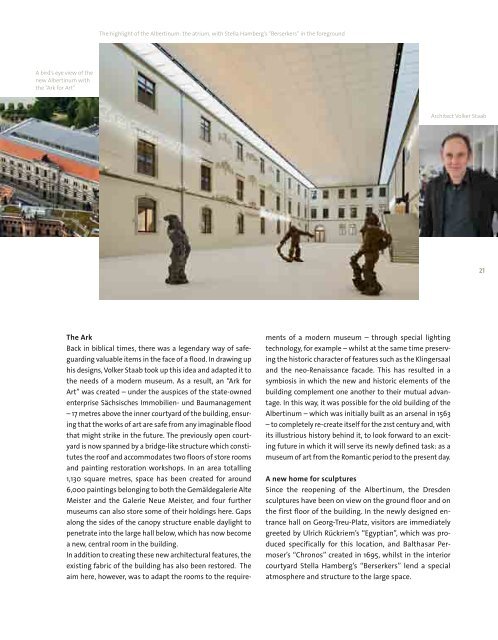Annual Report 2010 - Staatliche Kunstsammlungen Dresden
Annual Report 2010 - Staatliche Kunstsammlungen Dresden
Annual Report 2010 - Staatliche Kunstsammlungen Dresden
Create successful ePaper yourself
Turn your PDF publications into a flip-book with our unique Google optimized e-Paper software.
a bird’s eye view of the<br />
new albertinum with<br />
the “ark for art”<br />
the Ark<br />
The highlight of the albertinum: the atrium, with stella Hamberg’s “Berserkers” in the foreground<br />
Back in biblical times, there was a legendary way of safeguarding<br />
valuable items in the face of a flood. In drawing up<br />
his designs, Volker Staab took up this idea and adapted it to<br />
the needs of a modern museum. As a result, an “Ark for<br />
Art” was created – under the auspices of the stateowned<br />
enterprise Sächsisches Immobilien und Baumanagement<br />
– 17 metres above the inner courtyard of the building, ensuring<br />
that the works of art are safe from any imaginable flood<br />
that might strike in the future. The previously open courtyard<br />
is now spanned by a bridgelike structure which constitutes<br />
the roof and accommodates two floors of store rooms<br />
and painting restoration workshops. In an area totalling<br />
1,130 square metres, space has been created for around<br />
6,000 paintings belonging to both the Gemäldegalerie Alte<br />
Meister and the Galerie Neue Meister, and four further<br />
museums can also store some of their holdings here. Gaps<br />
along the sides of the canopy structure enable daylight to<br />
penetrate into the large hall below, which has now become<br />
a new, central room in the building.<br />
In addition to creating these new architectural features, the<br />
existing fabric of the building has also been restored. The<br />
aim here, however, was to adapt the rooms to the require<br />
ments of a modern museum – through special lighting<br />
technology, for example – whilst at the same time preserving<br />
the historic character of features such as the Klingersaal<br />
and the neoRenaissance facade. This has resulted in a<br />
symbiosis in which the new and historic elements of the<br />
building complement one another to their mutual advantage.<br />
In this way, it was possible for the old building of the<br />
Albertinum – which was initially built as an arsenal in 1563<br />
– to completely recreate itself for the 21st century and, with<br />
its illustrious history behind it, to look forward to an exciting<br />
future in which it will serve its newly defined task: as a<br />
museum of art from the Romantic period to the present day.<br />
A new home for sculptures<br />
Since the reopening of the Albertinum, the <strong>Dresden</strong><br />
sculptures have been on view on the ground floor and on<br />
the first floor of the building. In the newly designed entrance<br />
hall on GeorgTreuPlatz, visitors are immediately<br />
greeted by Ulrich Rückriem’s “Egyptian”, which was produced<br />
specifically for this location, and Balthasar Permoser’s<br />
“Chronos” created in 1695, whilst in the interior<br />
courtyard Stella Hamberg’s “Berserkers” lend a special<br />
atmosphere and structure to the large space.<br />
architect Volker staab<br />
21

















